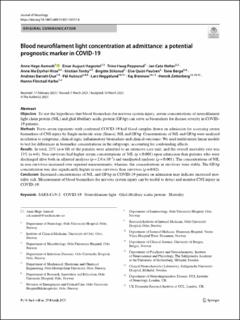Blood neurofilament light concentration at admittance: a potential prognostic marker in COVID-19
Aamodt, Anne Hege; Høgestøl, Einar August; Popperud, Trine Haug; Holter, Jan Cato; Dyrhol-Riise, Anne Ma; Tonby, Kristian; Stiksrud, Birgitte; Paulsen, Else Quist; Berge, Tone; Barratt-Due, Andreas; Aukrust, Pål; Heggelund, Lars; Blennow, Kaj; Zetterberg, Henrik; Harbo, Hanne Flinstad
Peer reviewed, Journal article
Published version
Permanent lenke
https://hdl.handle.net/11250/2760932Utgivelsesdato
2021-03-20Metadata
Vis full innførselSamlinger
Sammendrag
Objective To test the hypotheses that blood biomarkers for nervous system injury, serum concentrations of neurofilament light chain protein (NfL) and glial fibrillary acidic protein (GFAp) can serve as biomarkers for disease severity in COVID- 19 patients.
Methods Forty-seven inpatients with confirmed COVID-19 had blood samples drawn on admission for assessing serum biomarkers of CNS injury by Single molecule array (Simoa), NfL and GFAp. Concentrations of NfL and GFAp were analyzed in relation to symptoms, clinical signs, inflammatory biomarkers and clinical outcomes. We used multivariate linear models to test for differences in biomarker concentrations in the subgroups, accounting for confounding effects.
Results In total, 21% (n = 10) of the patients were admitted to an intensive care unit, and the overall mortality rate was 13% (n = 6). Non-survivors had higher serum concentrations of NfL (p < 0.001) upon admission than patients who were discharged alive both in adjusted analyses (p = 2.6 × 10–7) and unadjusted analyses (p = 0.001). The concentrations of NfL in non-survivors increased over repeated measurements; whereas, the concentrations in survivors were stable. The GFAp concentration was also significantly higher in non-survivors than survivors (p = 0.02).
Conclusion Increased concentrations of NfL and GFAp in COVID-19 patients on admission may indicate increased mor- tality risk. Measurement of blood biomarkers for nervous system injury can be useful to detect and monitor CNS injury in COVID-19.

